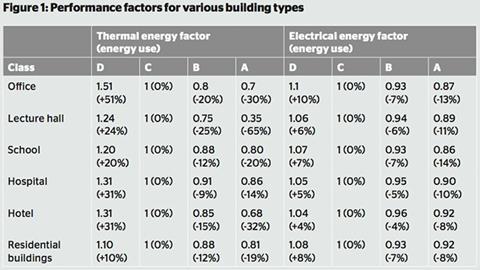This CPD module, sponsored by Schneider Electric, shows how the British and European standard BS EN 15232 can help building designers and managers to get the most out of integrated, automated control systems

How to take this module
UBM’s CPD distance-learning programme is open to anyone seeking to develop their knowledge and skills. Each module also offers members of professional institutions an opportunity to earn between 30 and 90 minutes of credits towards their annual CPD requirement.
This article is accredited by the CPD Certification Service. To earn CPD credits, read the article and then click the link below to complete your details and answer the questions. You will receive your results instantly, and if all the questions are correctly answered, you will be able to download your CPD certificate straight away.
CPD CREDITS: 30 MINUTES
DEADLINE: 14 NOVEMBER 2014

INTRODUCTION
��ɫ����TV automation control systems (BACS) create energy-efficient living and working environments that offer the highest level of comfort. BACS provide effective control of functions including heating, ventilation, cooling, hot water and lighting, which leads to improved operational and energy efficiencies. They also allow complex and integrated energy-saving functions to be configured based on the building’s actual requirements, avoiding unnecessary energy use and CO2 emissions.
This CPD will focus on the British and European standard BS EN 15232, Energy Performance of ��ɫ����TVs - Impact of ��ɫ����TV Automation, Controls and ��ɫ����TV Management, which was developed as part of a harmonised family of European standards that concern the calculation of a building’s energy performance and can be used to evaluate the energy savings achieved using BACS.

WHAT IS BS EN 15232?
This standard was created to establish conventions and methods for estimating the impact of building automation and control systems and technical building management on energy performance and use in buildings. The most recent version was published in February 2012, revising and extending the 2007 version.
BS EN 15232 specifies a method to estimate energy-saving factors which can be used in conjunction with an energy assessment of a building. It also supplements a series of standards drafted to calculate the energy efficiency of technical building services, such as heating, cooling, ventilation and lighting systems. It takes into account the fact that, with building automation controls and technical building management, the energy consumption of a building can be reduced, and should be used both for assessing existing buildings and during the design of new or renovated buildings.
BS EN 15232 aids compliance with both European and national legislation on the energy performance of buildings, including the following documents:
Energy Performance of ��ɫ����TVs Directive
The European Union Energy Performance of ��ɫ����TVs Directive (EPBD) was approved on 16 December 2002 and came into force on 4 January 2003, at which point EU member states were given until 4 January 2006 to implement it. The EPBD was transposed into British law by the Housing Act 2004, and the Energy Performance of ��ɫ����TVs Regulations 2007. The principal objective of the directive is to promote better energy performance of buildings within the EU through cost-effective measures.
The EPBD instructs member states to take measures to ensure that minimum energy performance requirements are set. It does not specify what the performance standards should be, nor how they should be arrived at - that is for determination by each member state. However, it does apply to all buildings, although different performance levels can be set for new and existing buildings. The performance requirements are to be based on the EPBD’s calculation methodology and are to be reviewed at least every five years.
��ɫ����TV Regulations, Part L
In the UK, the target energy performance of buildings is set by Part L of the ��ɫ����TV Regulations. The 2013 revision came into force in April 2014, imposing an improvement on the 2010 standard of 6% for domestic buildings and 9% on aggregate for non-domestic buildings. As well as implementing the EPBD, Part L raises performance targets, with the intention of achieving zero-carbon performance for new homes by 2016 and new non-domestic buildings by 2019.

TERMINOLOGY IN BS EN 15232
BS EN 15232 contains a number of specific terms, which are defined below.
- ��ɫ����TV automation and controls (BAC), ��ɫ����TV automation and control systems (BACS) A description for products, software and engineering services for automatic controls, monitoring and optimisation, human intervention and management to achieve energy-efficient, economical and safe operation of building services equipment.
- ��ɫ����TV management (BM) The totality of services involved in the management, operation and monitoring of buildings (including plant and installations). ��ɫ����TV management can be assigned as part of facilities management.
- Technical building management (TBM) TBM functions as part of building management and provides information about the operation, maintenance, services and management of buildings, especially for energy management. This includes measurement, recording trends, and notification and diagnosis of unnecessary energy use. Energy management involves providing documentation, controlling, monitoring, optimisation and determination to support corrective and preventive action to improve the energy performance of buildings.
PERFORMANCE CLASSES
There are four performance classes outlined in BS EN 15232, running from A to D.
- Class A: High-energy performance BACS and TBM For example, this would include control of heating and lighting at individual room level, with communication between controllers and a total interlock between heating and cooling; demand or presence-dependent air-conditioning and ventilation controls at room level and a variable setpoint with load-dependent compensation for supply temperature, and humidity control for room, exhaust or supply air; automatic daylight and lighting controls; blind controls integrated with lighting and HVAC systems.
- Class B: Advanced BACS and some TBM functions This includes control of heating and lighting at individual room level, with communication between controllers and a partial interlock between heating and cooling; time-dependent air-conditioning and ventilation controls at room level with a variable setpoint for outdoor temperature compensation and humidity control for room, exhaust or supply air; automatic lighting controls, but manual daylight controls; motorised blinds controlled automatically.
- Class C: Standard BACS, the benchmark class This includes control of heating and lighting at individual room level by thermostatic valves or electronic controllers and a partial interlock between heating and cooling; time-dependent air-conditioning and ventilation controls at room level with supply temperature at a constant setpoint, and humidity limitation of supply air; manual daylight and lighting controls; motorised blinds controlled manually.
- Class D: Non-energy-efficient BACS This class includes no automatic control of heating and cooling with no interlock between them; no control of airflow at room level, supply temperature or air humidity; manual control of daylight and lighting; manual operation of blinds.
These classes apply to both domestic and non-domestic buildings. A system’s class is set by its weakest point - the lowest class to which an entry has been assigned within table 2 of BS EN 15232. Even if a system met class B for every category except one, for which it was assigned to class C, then the building would be evaluated as class C, because it does not fulfil all the criteria for a class B system.

CALCULATION METHODOLOGY
BS EN 15232 provides two methods for calculation of a building’s class: the factor method (basic), and the detailed factor method (complex). The detailed method requires precise, in-depth knowledge about how the BACS system will be used and its precise capabilities. In the absence of detailed data, the basic method provides a good overview of the current level of energy efficiency and the potential benefits of an upgrade to the BACS, though it does not include all the elements of a building.
Under the detailed method, there are five different approaches to calculating the potential impact of building automation, as follows:
- Direct: using detailed methods as described in BS EN ISO 13790, Energy Performance of ��ɫ����TVs, Calculation of Energy Use for Space Heating and Cooling
- Operating mode: by evaluating the energy consumption of climate systems sequentially for each operating mode
- Time: used when the control system has a direct impact on the operating time of a device
- Temperature: used when the control system has a direct impact on the room temperature
- Correction coefficient: used when the control system intervenes in a more complex way (for example, there is a combined effect on time and temperature).
The basic calculation method facilitates an approximate evaluation of the impact of BACS and TBM systems on the building’s energy performance over the course of a year.
Table 2 within BS EN 15232 is used to calculate the building’s performance. It is split into sections on heating, domestic hot water, cooling, ventilation, lighting, blinds and TBM, within which there are a number of criteria that must be assessed. For each, a cross is marked next to the appropriate class. This produces two sets of BACS efficiency factors: thermal energy, used for heating and cooling (fBAC,hc), and electrical energy (fBAC,e), used for lighting and other systems.
The table below demonstrates the relative performance of each class for various building types, giving the factor applied under BS EN 15232 and also the percentage savings for thermal and electrical energy.


How to take this module
UBM’s CPD distance-learning programme is open to anyone seeking to develop their knowledge and skills. Each module also offers members of professional institutions an opportunity to earn between 30 and 90 minutes of credits towards their annual CPD requirement.
This article is accredited by the CPD Certification Service. To earn CPD credits, read the article and then click the link below to complete your details and answer the questions. You will receive your results instantly, and if all the questions are correctly answered, you will be able to download your CPD certificate straight away.
CPD CREDITS: 30 MINUTES
DEADLINE: 14 NOVEMBER 2014.
Privacy policy
Information you supply to UBM Information Ltd may be used for publication and also to provide you with information about our products or services in the form of direct marketing by email, telephone, fax or post. Information may also be made available to third parties. UBM Information Ltd may send updates about ��ɫ����TV CPD and other relevant UBM products and services. By providing your email address you consent to being contacted by email by UBM Information Ltd or other third parties. If at any time you no longer wish to receive anything from UBM Information Ltd or to have your data made available to third parties, contact the Data Protection Coordinator, UBM Information Ltd, FREEPOST LON 15637, Tonbridge, TN9 1BR, Freephone 0800 279 0357 or email ubmidpa@ubm.com. View our full privacy policy at






















No comments yet